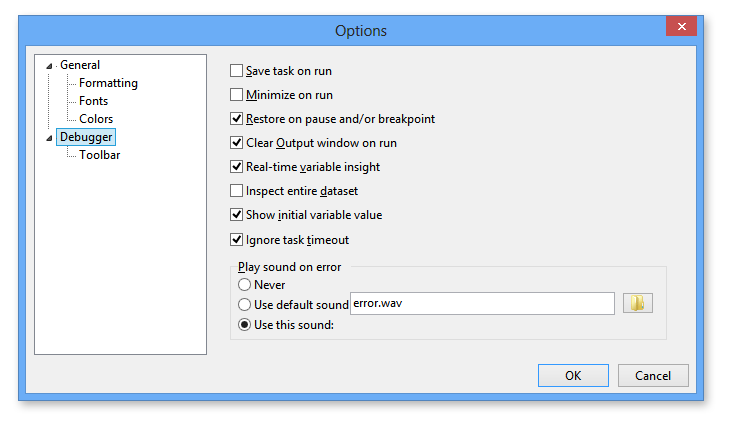
Task Builder Debugger Options |
The Task Builder includes settings that affect its behavior while running a task. In some cases you may want to change these settings to better fit your debugging needs. For instance, you can opt to minimize the Task Builder window during execution to better examine an interactive task, automatically clear the Output Debug Panel after each run, or play a custom sound when an error occurs. Debugger options is a subset of Task Builder Options.

The following table describes available Debugger options.
Property |
Default |
Description |
Save task on run |
Disabled |
If enabled, Task Builder automatically saves changes made to a task when clicking the Run button. If the task has not been saved yet, will prompt the to save before running. This parameter is disabled by default. |
Minimize on run |
Disabled |
If enabled, the Task Builder window minimizes to the system tray when execution starts. When the task ends, the Task Builder restores itself and highlights the current step or displays Finished as the step status in the status bar. NOTE: The default behavior of the Task Builder is to stay on the desktop (does not minimize or hide itself) while a task is running. When testing tasks that include interactive actions (e.g.,Send Keystrokes, Move Mouse to Object actions) or actions that interact with other windows (e.g.,Maximize Window, Minimize Window actions), if set to default, the Task Builder window may interfere with the actions being performed by a task. This may result in a Send Keystrokes step, for example, failing to send keystrokes to the proper window or application. Enabling the Minimize on run option will remedy such an issue. |
Restore on pause and/or breakpoint |
Enabled |
If enabled, when task execution is manually paused (when a user clicks the Pause button) or pauses at a breakpoint, and the Task Builder window is currently minimized, it restores itself and highlights the current step. When execution continues, the Task Builder window, once again, minimizes to the system tray. |
Clear output window on run |
Enabled |
If enabled, clears the contents of the Output debug panel before the task starts its execution. If disabled, new debugging output is appended to existing output accumulated from a previous task run. |
Real-time variable insight |
Enabled |
The Task Builder maintains a list of variables in the current task which can be viewed in the Variables Debug Panel. At runtime, this panel also shows the current value of these variables. If this option is enabled, the panel is updated after each step is executed to show the current variable value. If disabled, the panel is updated only when the task is paused (by clicking the Pause button or when a breakpoint is encountered), while stepping through the task with the use of the Step button, and when the task ends. NOTE: Enabling this option could cause tasks to execute somewhat slower while debugging (it does not affect execution speed when not debugging, however). |
Inspect entire dataset |
Disabled |
Datasets contain a number of properties that are not usually displayed in the Variable Window. These properties are used, for example, to view the date/time the dataset was created, the total number of rows in the dataset, etc. If enabled, this option displays these extended dataset properties in the Variables Debug Panel when the task is run. |
Show initial variable value |
Enabled |
If enabled, causes the Variables Debug Panel to include a column for Initial Value in addition to the Current Value column. If this is disabled, only the current value is shown. |
Ignore task timeout |
Enabled |
If enabled, the task timeout value set under the Error Causes properties of the task is ignored. |
Play sound on error |
Error.wav |
Selects whether to play a sound when the task stops as a result of an error. Regardless of this setting, when a step fails, it is always colored using the Error color set in the Color Options (default is red). Also, task execution stops, and the error is written to the Output Debug panel. The selections are:
|